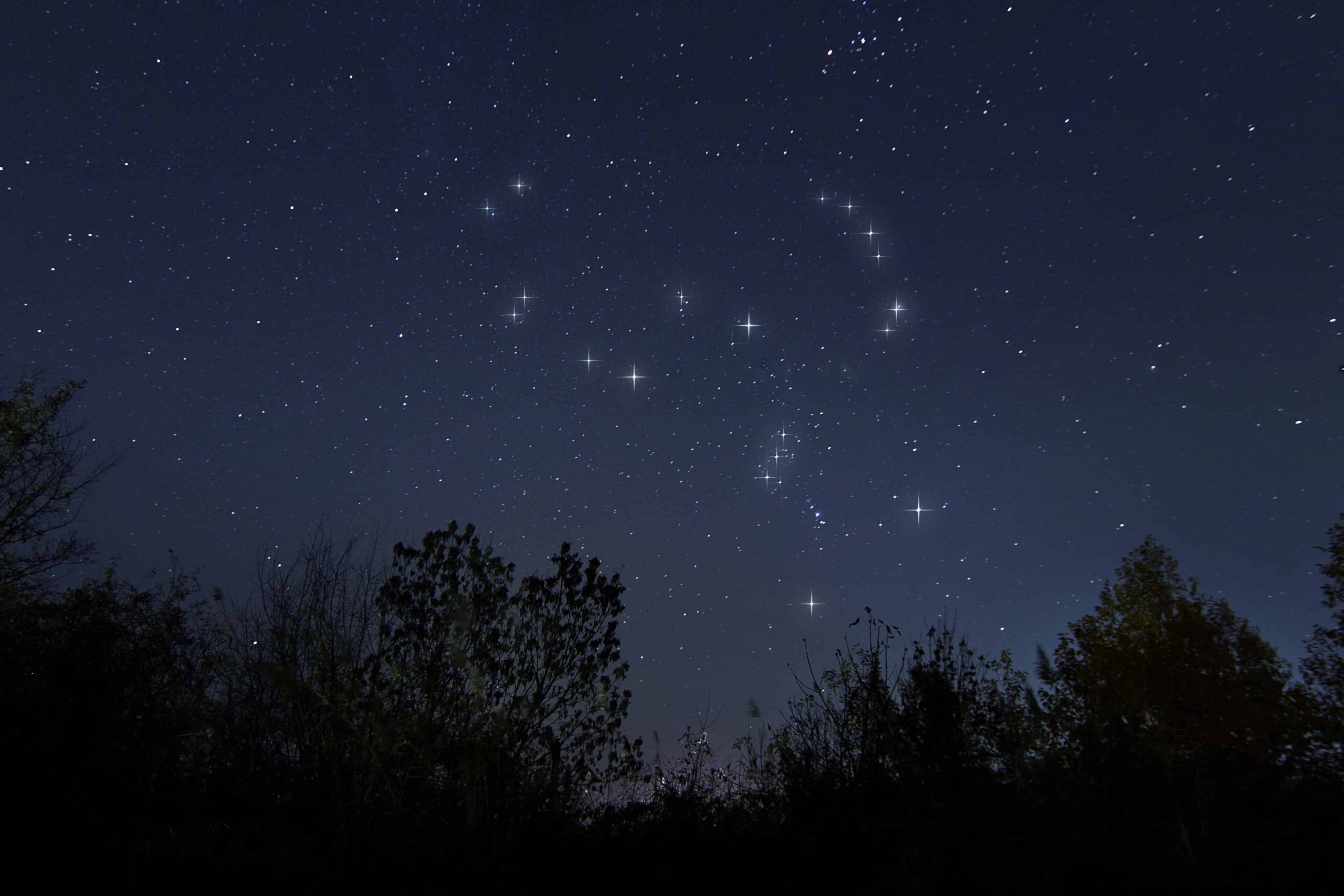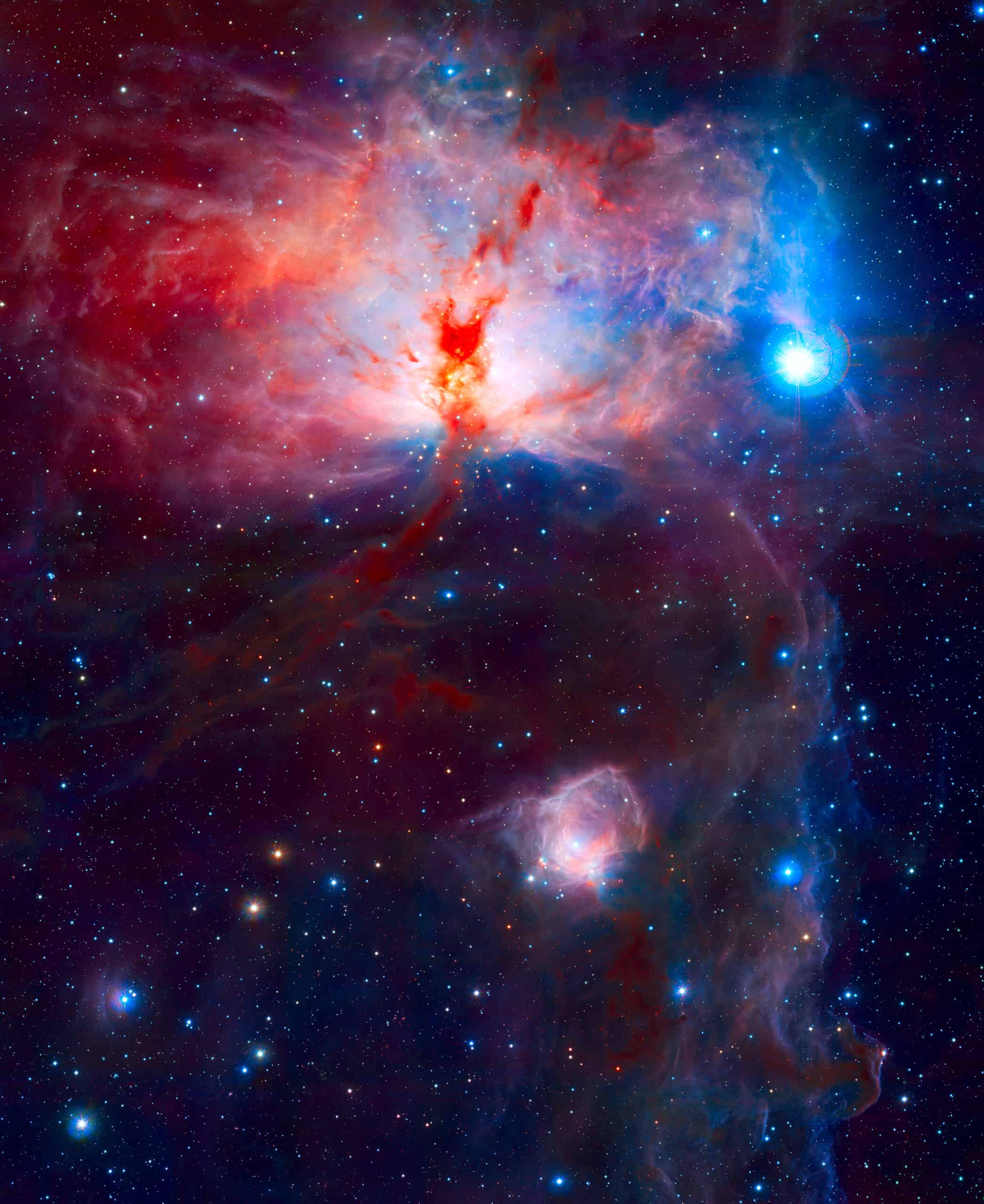Lying on the celestial equator, the constellation of Orion is one of the most recognizable and well-known constellations in the night sky. It is visible in both hemispheres from November to March, hitting the meridian at sunset in January. The areas in and around Orion are home to one of the most glorious parts of the sky, containing five of the brightest stars in the heavens: Sirius, Capella, Rigel, Procyon, and Betelgeuse.
Contents
The Legend of Orion
Orion is most commonly referred to as “Orion the Hunter” because of its origins in Greek mythology. The legend of the constellation of Orion has many different versions and can be found in the mythology of many cultures. In ancient Greece, it was told that he lived a tragic life, one that came to an end unintentionally by the arrow of Artemis as he was escaping a scorpion. Out of pity, the gods placed Orion among the stars, surrounded by his dogs, Canis Major and Canis Minor, as well as celestial animals for him to hunt: Taurus, the bull, and Lepus, the rabbit. As a courtesy to him, Scorpius the scorpion was also placed in the opposite half of the night sky, appearing highest during July.
In ancient Egypt, Orion was replaced with Osiris, the god of the underworld who was slain by his brother Set. His wife, Isis, reassembled him and brought him back to life, giving Osiris immortality and placing him amongst the stars. Isis, represented by the star Sirius, follows Osiris across the sky each winter night.
In ancient China, Orion was hailed as a warrior defending the local farmers’ food stores against raiders during the winter. Some nations like the Najavo even used the position of Orion as a sign of when to plant their crops, planting when Orion began to set at dusk in the early summertime.
Location
The constellation of Orion is relatively medium-sized, the 26th largest in the night sky out of the 88 total constellations. Since it is centered just above the celestial equator, it is visible from latitudes of +85° to -75°. It sits between the neighboring constellations of Gemini, Eridanus, Monoceros, Taurus, and Lepus, marked by its three bright stars of “Orion’s belt”: Alnitak, Alnilam, and Mintaka.
Constellation of Orion as illustrated by the IAU and Sky & Telescope
Orion can be seen at the meridian (the invisible line that splits East from West) at 9 pm local time during January, centered at 5 degrees North latitude. This means that if your latitude is at 5 degrees, you will see the constellation at the zenith directly over your head. If your location is above five degrees in latitude, you will see Orion to the south of you and the north if your site is below that. This means that observers in the northern hemisphere see Orion right-side up, while observers in the southern hemisphere see it upside down.
Named Stars in Orion
Meissa (λ Orionis)
Meissa is a double star with a blue giant located approximately 1,300 light-years away paired with a main-sequence B-class companion, from which it is separated by 4 arcseconds. The formal name Meissa comes from the Arabic Al-Maisan, which means ‘The Shining One.’ Al-Maisan was originally used for the star Gamma Geminorum (Alhena) but was accidentally applied to Lambda Orionis and was never corrected.
Meissa can be found near the “head” of Orion in a triangle of three dim stars that range from apparent magnitude 3.5 to 4.5.
Hatysa (ι Orionis)
Hatysa is a quadruple star system located 1,300 light-years away, as well as the brightest star in Orion’s sword at magnitude 2.77. The star’s Arabic name origins translate to “the bright one of the sword.” The primary components of the system are a binary blue giant and a class B1 star, whose stellar winds produce an intense storm of X-rays that can be detected with instruments here on Earth.
Hatysa can be seen with the naked eye and is located just South of the most gaseous part of the Orion Nebula (Messier 42).
Saiph (κ Orionis)
Saiph, which translates to “the sword of the giant,” is one of the most southeastern stars in the constellations and can be seen as one of Orion’s feet. With an apparent magnitude of 2.05, Saiph is a blue supergiant that will end its life as a bright supernova, much like many of the other bright stars in the constellation.
Alnitak (ζ Orionis)
Alnitak, translating to “the girdle,” is a multi-star system located 700 light-years away and is the easternmost star in Orion’s belt. Alnitak A, the brightest star in the system, is a blue supergiant with a similar magnitude and lifecycle as Saiph.
Alnitak can be found on the east side of Orion’s belt, lying right next to NGC 2024, the Flame Nebula, as well as the Horsehead Nebula.
Alnilam (ε Orionis)
Alnilam is the middle star in Orion’s Belt, a hot blue supergiant located 1,300 light-years distant. It is referred to as “the string of pearls” in its Arabic translation. At an apparent magnitude of 1.65, Alnilam sits as the fourth brightest star in Orion and the 30th brightest star in the entire night sky.
Mintaka (δ Orionis)
Mintaka is the westernmost star in Orion’s Belt, as well as the dimmest, at an apparent magnitude of 2.4. Mintaka is derived from an Arabic word that translates to “area” or “region.” It is a multi-star system, its main components an eclipsing binary variable consisting of a class B giant and a hot class O star that eclipse each other and create a 0.2 magnitude drop when observed from Earth.
Bellatrix (γ Orionis)
Bellatrix, referred to as “the female warrior,” is a blue-white giant star with a variable apparent magnitude of anywhere from 1.59 to 1.64. Its blue appearance is due to its extremely hot temperature, four times hotter than our Sun and more than 6,000 times more luminous.
Bellatrix is one of the northwestern stars of Orion and can be imagined as one of his shoulders, the one connected to his bow on the west side.
Betelgeuse (α Orionis)
Betelgeuse is one of the most well-known and well-loved stars of the night sky, recognized by its strong orange glow and the eighth brightest star in the sky. Betelgeuse is a variable star, ranging from apparent magnitudes of 0.2 to 1.2. Despite only being 10 million years old, astronomers believe that Betelgeuse is approaching the end of its life very rapidly because of its extreme mass. Because of its size and close proximity to us (643 light-years), its death will be something special to witness here on Earth, with the ability to outshine even the moon, showing up in the daytime and being the brightest supernova in recorded history.

Betelgeuse can be found on the eastern side of Orion, the opposite shoulder of Bellatrix, easily recognized by its bright orange tint.
Rigel (β Orionis)
Rigel is the brightest star in the constellation, sitting at an apparent magnitude of 0.15. The name comes from the Arabic translation that means “the left foot of the central one,” implying that the star is the left foot of Orion. Rigel is a triple star system, as well as a known visual binary. At only 770 light-years away, it is 85,000 times more luminous than the sun and is 17 times bigger. It is also a variable star, ranging from magnitude 0.03 to 0.3 over the span of slightly less than a month.
Rigel, the left foot of Orion, illuminates large clouds of dust, the most well-known of which is the Witch Head Nebula, a popular astrophotography target and very dim visual target.
Deep Sky Guide
Barnard’s Loop
Barnard’s loop is a massive emission nebula located in the Orion Molecular Cloud Complex. At a radius of over 150 light-years, Barnard’s Loop covers a vast majority of the constellation of Orion, forming a red dust ring around the constellation’s perimeter. Because of its low surface brightness, it is best seen in long-exposure photographs, making it a popular target for wide-field astrophotographers. However, under extremely dark sky conditions, experienced observers may be able to faintly see it with the naked eye.
Orion Nebula (Messier 42)
Messier 42, known as the Orion Nebula, is a diffuse emission reflection nebula located within Orion’s sword. M42 is one of the brightest nebulae in the night sky, easily seen with binoculars and even with the naked eye as a faint fuzzy under dark sky conditions. It has an apparent magnitude of 4 and is 1,344 light-years from Earth, making it the closest known region of active star formation to us. Through a telescope, especially ones of a larger aperture, there are hints of pink and green hues which make it an exciting target to observe.
Within the Orion Nebula sits the Trapezium Cluster, an open cluster of young stars less than 300,000 years old that take on the form of a trapezoidal-shaped asterism. This asterism was first discovered by the great Galileo Galilei in 1617, but he could only see three of the stars with his small, rudimentary refractor telescope. Today, modern instruments allow us to see eight stars in the cluster, with most basic amateur astronomers able to easily see four (A, B, C, D stars), and sometimes six (E & F stars) on a night of great seeing and transparency.
Horsehead Nebula (Barnard 33)
The Horsehead Nebula, also known as Barnard 33, is a well-known dark nebula in Orion’s belt. Located slightly south of the bright star Alnitak, it was first discovered by astronomer Williamina Fleming in 1888 using an 8” doublet refractor and plate photography, appearing as a “semicircular indentation” in the photograph.
The Horsehead Nebula, image credit: Jordanne Brisby

Williamina Fleming – Portrait courtesy of Special Collections, Fine Arts Library/Harvard University
This object is a tough visual target, usually requiring a telescope of 10” of aperture or more, along with the assistance of an H-beta filter to increase the contrast of the hydrogen gases. However, for those who are more into photography than visual astronomy, long-exposure images paired with a narrowband filter really bring out the shape of the horsehead and its surrounding gas clouds.
The Flame Nebula (NGC 2024)
The Flame Nebula, cataloged as NGC 2024, is an emission nebula in Orion’s belt. The nebula is illuminated by the light of Alnitak, the easternmost star in the belt. Alnitak floods the gas cloud with ultraviolet light, ionizing the hydrogen atoms within it and allowing it to glow.

Its neighbor, the Horsehead Nebula, makes for a difficult visual target, but the flame is easy to see in small telescopes under even brighter sky conditions, recognized by its bright glowing gases next to Alnitak, along with lanes of darker, thicker gas striking through the center of the nebula.
De Mairan’s Nebula (Messier 43)
De Mairan’s Nebula, cataloged by Charles Messier as Messier 43, is a star-forming emission-reflection nebula located in the northeastern quadrant of the Orion Nebula (M42). DE Mairan’s Nebula is technically part of the Orion Nebula but is separated from the rest of it by a large, dark dust lane. It holds an apparent magnitude of about 6.8 and is 1,600 light-years from us.
De Mairan’s Nebula can easily be spotted visually in a telescope or binoculars by looking roughly 7 arcminutes directly north of the Trapezium cluster, the trapezoidal asterism in M42.
Monkey Head Nebula (NGC 2174)
The Monkey Head Nebula is an H-II emission nebula located in the far northeastern quadrant of the Orion constellation, inside of the open cluster NGC 2175. It is named such due to its unusual shape in photographs, caused by the stellar winds and high-energy radiation from young stars near the center.
It cannot be seen with the naked eye but can be seen in telescopes under dark-sky conditions. It can be a bit difficult to find without the aid of setting circles or go-to since it is a bit far from well-known asterisms or bright stars. On a large-scale side of things, it sits in the center of the triangle formed by Betelgeuse, Procyon, and Capella, and is just to the southwest of Tejat and Propus, two dim stars in Gemini, where the northernmost leg of the twins meets the left hand of Orion.
The Witch Head Nebula (IC 2118)
The Witch Head Nebula is a faint reflection nebula that is currently believed to be the remnants of an ancient supernova or a cloud of gas illuminated by nearby star Rigel. This star is a few degrees to the east of it. The blue-hued nebula sits almost perpendicular to the southwest side of Barnard’s loop, creating an awesome juxtaposition of color when photographed.
As a visual target, unfortunately, there is not much to see. The Witch Head itself is mostly invisible to visual observers, with marginal improvements possible by using a broadband light-pollution filter, observing from a dark site, and having a bit of imagination.
Messier 78
Messier 78 is a reflection nebula discovered by Pierre Méchain in 1780 and was then included in Charles Messier’s catalog later on. With an apparent magnitude of 8, it is visible in small telescopes (as are all Messier objects). It can be found stuck right in the middle between Alnitak and slightly dimmer star 56 Orionis. M78 is the brightest diffuse reflection nebula inside of the Orion B molecular cloud complex and is located about 1,350 light-years from Earth.
M78 is seen in small telescopes as a hazy gas patch with two stars of 10th and 11th magnitude: HD38563A and HD38563B. These two stars are responsible for the glow that makes the nebula visible to us here on Earth. There is also a multitude of stars visible in the infrared spectrum, including 45 T Tauri variable stars and 17 Herbig-Haro objects, indicating that there is active star formation occurring in M78.
NGC 2169
NGC 2169 is an open star cluster located approximately 3,600 light-years from us. The cluster was discovered by Italian astronomer Giovanni Batista, but was also spotted by William Herschel and cataloged sometime later. A popular nickname for this cluster is the “37 cluster” because of its slight resemblance to the number 37.
This open cluster is moderately easy to find, slightly south of and forming a triangle with 70 Orionis and 67 Orionis, the two stars halfway up Orion’s left arm. The entire cluster only spans about 7 arcminutes, with its brightest component having an apparent magnitude of 7.
NGC 2023
NCG 2023 is a reflection nebula that was discovered by William Herschel in 1785 and is recognized as a bright spot just below the Horsehead Nebula in Orion’s belt. This nebula is lit up by the pre-main-sequence star HD37903, making it one of the brightest sources of fluorescent molecular hydrogen that we know of.
At magnitude 8, It can be found less than 20 arcminutes east of the Horsehead Nebula in most amateur telescopes and is a good bit brighter than the surrounding area, making it easier to find.

